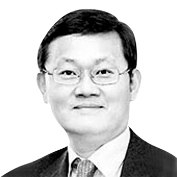China dream challenges

The author, former chief economist at the Asian Development Bank and a senior adviser for international economic affairs to former President Lee Myung-bak, is a professor of economics at Korea University.
When he was inaugurated in 2012, Chinese President Xi Jinping promised to achieve the Chinese dream of restoring the “Great Chinese Race.” He vowed to realize the first centenary goal of building a “xiaokang (moderately well-off) society” by 2021 when the Communist Party of China (CPC) celebrated the 100th anniversary of its founding. Xi went on to pronounce a second goal of constructing a “modernized socialist power” by 2049, the centennial of the founding of the People’s Republic of China.
On July 1, in an address celebrating the 100th year since the founding of the CPC, Xi announced the country had achieved the first goal in all aspects. Since its founding in 1949, China had many stumbles under its socialist system. But since the reform and opening under Deng Xiaoping in 1978, the country has made staggering advances. The government has promoted market activities and competition. It led state infrastructure projects and encouraged exports. Over the last three decades of opening, its gross domestic product (GDP) expanded more than 10 percent on average. Most people no longer live in poverty. By scale, China is the No. 1 exporting country and No. 2 economic power in the world. It is home to global enterprises like Xiaomi, Alibaba, Tencent and Huawei.
There is no definitive answer to which of the two systems — democracy or dictatorship — is more advantageous for economic development. In theory, authoritarianism can slow economic progress as production can be depressed when a minority dominates power and exploits a majority of economic participants. China’s political system is far from a democracy. In 1989, Beijing suppressed a democracy movement in Tiananmen Square, killing and arresting thousands of pro-democracy protesters. Still, its authoritarian system contributed to economic advancement. A strongman backed by one-party rule led to efficient economic progress.
Will the same system ensure the success for the next 30 years? China’s per capita GDP stood at $10,500 in 2020, compared to South Korea’s $31,489. On personal income, Chinese are still at the 1990 level of South Koreans. South Korea endured several economic crises and political turbulence over the past three decades. China is expected to undergo political and economic turmoil over the next generation. To achieve the next centennial goal for 2049, China has to address big challenges at home and abroad.
First of all, the Chinese economy won’t be able to keep up its past pace. The working population aged from 15 to 64 has been thinning from a low birth rate and aging populations. According to a UN projection, China would see a 170 million population decline over the next 30 years. Investment yield rate and productivity growth have stagnated. The financial sector remains fragile and heavy debts for corporations and local governments could trigger a financial crisis. The growth rate between 2012 and 2020 slowed to 6.5 percent on average and the pace is expected to slow to 3 to 4 percent over the next 30 years.
The state-led growth model cannot work efficiently in the future. The private sector has become too big for government control. Beijing has tamed Alibaba’s Jack Ma and ride-sharing platform Didi for now, but its command over the private sector is bound to weaken.
China also cannot maintain political stability by authoritarian means. As the well-educated middle class grows, more people demand political freedom. Over 700 million are categorized as middle class and the ratio of college educated shot up to 54 percent from 8 percent in 2000. The suppressed voice could explode any time. Anything could be a tipping point. Political instability and simmering social conflict over a wide gap among regions and classes could get worse.
Unfavorable external conditions also can hinder the Chinese dream. China cannot export as in the past due to difficulties in getting raw materials parts from the global supply chain. Due to a conflict with America, accessing the U.S. market and high-tech is not easy anymore. The Chinese dream Xi envisions is to create Pax Sinica, or a China-led global order. But the U.S. remains the superpower in politics, economy, currency, finance, energy, science and culture. China won’t be able to catch up with America for quite a long time.
Whether China will accept democratic values and emerge as a less threatening developed nation remains a question. If its conflict with the U.S. develops into military clashes in East Asia or when the country emerges as a hegemony based on autocracy, the impact on South Korea will be huge. Seoul must keep watch and reinforce its readiness against the changes in China through cooperation with allies.










with the Korea JoongAng Daily
To write comments, please log in to one of the accounts.
Standards Board Policy (0/250자)